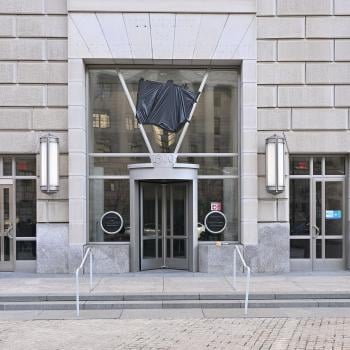Where the Devil is Satan (in Contemporary Christianity)?
When I write about “contemporary Christianity,” for the most part, I’m addressing what I see as my own religious-cultural context—moderate, centrist, evangelically-oriented Protestantism in the U.S. I’m not usually (unless I say otherwise) addressing fundamentalist or liberal Protestantism or Roman Catholicism.
I hold in my hand a copy of the so-called Jefferson Bible (officially titled The Life and Morals of Jesus of Nazareth) created by Thomas Jefferson. In spite of some revisionist historians’ claims, it was not created as a tool of evangelism of native Americans. Jefferson explained very clearly, in letters to John Adams among others, why he created it. He admired Jesus but disagreed with much of what he said and most of what the writers of the gospels claimed about him. So, he cut everything out of the gospels he thought conflicted with reason and left only those teachings and acts of Jesus he considered admirable and believable.
Evangelicals especially love to use Jefferson’s truncated New Testament as an example of what goes wrong when we come to the Bible with interpretive lenses determined by culture and philosophy rather than, in the inimitable words of theologian Hans Frei, allow the Bible to “absorb the world.” And yet, it seems to me, we (especially moderate to progressive) evangelicals (and other Christians) do it all the time.
A glaring example, it seems to me, is the way we have exorcised Satan and demons from our New Testaments. Oh, sure, we haven’t literally cut all references to them out of our Bibles, but we have gotten used to ignoring them or “interpreting” them non-literally. We are, it seems to me, extremely uncomfortable with believing in Satan or demons—except perhaps as personifications of the evil that humans do.
But it seems to me that’s very difficult to do while attempting to take the New Testament seriously. Satan is all over in it; he’s a major player, a significant character in the narrative.
Some years ago my family and I were members of a church that advertised itself as “evangelically committed, ecumenically open.” The pastor announced he would teach a series on the Gospel of Mark on Wednesday evenings. The first evening he let us know that he did not believe in a literal Satan or demons. He explained that the believed them to be primitive personifications of human evil and mental illness or diseases. I wasn’t shocked as I knew that is fairly common among such moderate, centrist churches. (He did believe in the deity of Jesus Christ, the Trinity, salvation by grace alone, etc.) But I told him publicly that I would be interested to see how he handled Mark 5—Jesus’ exorcism of the demons from the “Gerasene demoniac”—the man possessed of many demons. According to the story, the demons leave the man but enter a herd of swine which then rushes off a cliff. The pastor never did get to Chapter 5 in his series on Mark.
Most conservative Protestants will not openly or blatantly deny the non-symbolic existence of Satan or demons and, if pressed, will claim to believe in them as non-symbolic realities of some kind. But, in my experience, anyway, most such pastors and theologians do not really want to deal with them. They are left aside and rarely mentioned in sermons, Sunday School lessons, and Bible studies.
My question is—why? Why do those Christian pastors and teachers who claim to take the Bible seriously, claim to love C. S. Lewis (author of The Screwtape Letters), claim to stand in basic continuity with historic, orthodox Christianity, so seldom even mention Satan or demons when the New Testament is full of them?
It seems to me there are two interrelated reasons and a third. First, many such pastors and teachers grew up in fundamentalist or Pentecostal contexts where Satan and demons were over-emphasized. I recall, for example, seeing a book in our church’s library (and in some members’ homes) that claimed to contain illustrations of demons “seen” by a woman. The book gave me nightmares! Another popular book in my religious milieu was Pigs in the Parlor: A Practical Guide to Deliverance. You would have to see it to believe it. Another book guaranteed to give children (and maybe some adults!) nightmares.
A second, related reason, I think, is our moderate Protestant craving for cultural respectability. Belief in a literal Satan and demons seems, however nuanced, guaranteed to bring scorn from sophisticated people living under the influence of the Enlightenment.
A third reason may be the influence of philosophical reasoning, channeled through rational apologetics, among evangelicals (including many who consider themselves moderate, centrist). A big part of such apologetics is theodicy—the explanation of evil in light of the existence of God. Theodicy rarely finds place for Satan or demons in explaining the existence of evil in God’s universe.
I’m tempted to add a fourth possible reason for the disappearance of Satan and demons and that is Calvinism. If God is the all-determining reality and Satan is just God’s instrument (however explained as a “secondary cause”) then why focus any attention on him it all? Go right to the ultimate cause of everything including evil—God. But, of course, Calvinist theologians generally do not deny Satan. But I suspect many pastors and lay people who teach in Calvinist churches do not see the point of Satan if God is the all-determining reality and so what’s the harm in leaving mention of him aside?
I struggled with this issue for a long time—how to believe in what I’ll here call “Satanic realism”—Satan and demons are real beings and not merely symbolic representations of evil without falling into fanaticism or leaving behind reason.
A bit of autobiography will help explain my dilemma and its solution (however partial) and, hopefully, resonate with some readers and help them.
I earned my post-seminary Master of Arts and Ph.D. degrees in Religious Studies (with heavy emphasis on Christian theology) at a major, secular, national research university. As a graduate fellow I was assigned to help teach a course on C. S. Lewis to undergraduates. It was a team taught course with the chair of the Religious Studies department overseeing the two of us (graduate students) who actually taught the course. Of course, we read The Screwtape Letters and other books by Lewis that included Satanic realism. But some students and others argued that it was all allegory and not at all to be taken literally. I recall several heated conversations with fellow graduate students over Satanic realism; most of them considered it primitive, pre-modern belief not to be taken seriously by anyone in such a context.
For a while, then, I seriously considered latching on to Karl Barth’s idea of Satan as “Das Nichtige”—“that Nothingness”—the power of evil that comes into being (or not-being but existing) as that which God does not will and opposes. After careful consideration, however, that did not seem plausible in light of the Satanic realism of the New Testament.
During my fifteen years teaching theology at a moderate, centrist evangelical college and seminary, I taught an elective course on “America’s Cults and New Religions” (which I promoted as “Unsafe Sects” to get students to register for it). During that time I encountered many, many convincing evidences of Satanic realism in the dark underworld of American occultism. And I read many books about the occult in modernity that seemed to support Satanic realism in spite of the Enlightenment taboo against it.
I will just mention one personal experience I had that seemed to me to provide experiential support for continuing belief in Satanic realism. As part of my research for my course I visited some occult shops in the metropolitan area where I lived. They were more numerous than most people knew. One in particular I had come to know as a favorite hangout for both Wiccans and Satanists. (A Wiccan high priestess told me this and claimed that the Wiccans would have nothing to do with the Satanists but that they came there anyway—to purchase books on occult power to use for their nefarious purposes.)
I drove up to the bookstore, parked across the street and attempted to get out of my car. As usual, I had prayed for divine protection during my drive there. I found myself literally unable to get out of my car. I sat there for a very long time trying to exit the car but could not. It wasn’t fear; I’ve been in many occult and esoteric bookshops and was not afraid of any mere bookstore. As I sat there pinned inside my car by some mysterious force, I remembered praying for divine protection. Eventually I pulled away and never did go inside that bookstore.
Two books appeared about that time that strongly influenced me to continue believing in Satanic realism—I Believe in Satan’s Downfall by Michael Green and People of the Lie by M. Scott Peck. The first one is, of course, a theological treatment of what used to be called “Demonology” in Christian theology, and the second one is a semi-autobiographical testimony of coming to belief in Satanic realism and demonic possession by a secular psychologist who became a Christian in part, at least, because he could not explain the pathology of some patients without belief in Satan.
As for the first book—I Believe in Satan’s Downfall—I cannot recommend it highly enough, especially for Christians who struggle with belief in Satanic realism and want a reasonable, biblically faithful, account of demonology that avoids extremes and is rooted in revelation and Christian tradition.
It seems to me that moderate, centrist Protestants need to overcome our own pathologies including 1) throwing the baby out with the bathwater (of fundamentalism or Pentecostal extremism), 2) seeking respectability from Enlightenment-based culture, and 3) being fascinated, if not obsessed, with rational apologetics including theodicies that have no room for Satanic realism.












